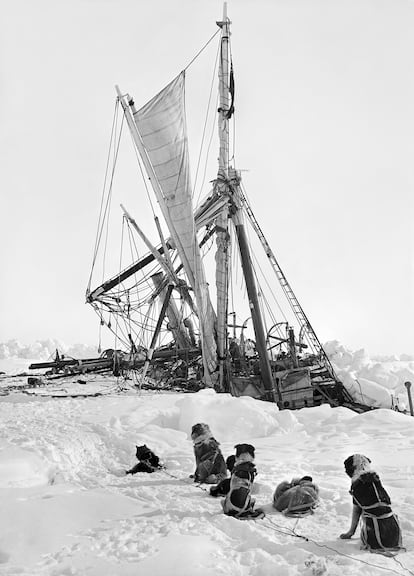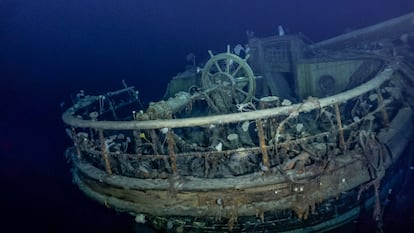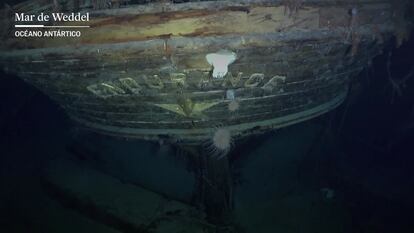Shackleton’s legendary ‘Endurance’: One of polar exploration’s most famous vessels located in Antarctica
The ship went down in the Weddell Sea in 1915 after being trapped in pack ice for nine months, leading to a celebrated escape to safety over land and sea

A scientific expedition working aboard a South African ice-breaker, the Agulhas II, has discovered the Endurance, arguably the most famous vessel in the history of polar exploration, whose name has gone down in the history alongside the Fram, the Terra Nova, the Discovery, and the Erebus and Terror – the doomed ships of Captain Sir John Franklin’s expedition, of which there were no survivors. The Endurance was located in the Weddell Sea, the gateway to the Antarctic, at a depth of 3,000 meters, not far from where the crew recorded its last coordinates before it was claimed by the depths on November 21, 1915, crushed by the pack ice in which it had been trapped for almost a year. The 28-strong crew of the Endurance was saved by their courage and determination, and the bold response to the disaster of the expedition’s leader, Sir Ernest Shackleton, with his men stranded in one of the most inhospitable environments on the planet. Their subsequent escape is considered one of the greatest feats of the age of Antarctic exploration and one that honored the name of their stricken vessel.
The captain of the Endurance, Frank Worsley, took careful measurements with his sextant and chronometer of the location where the ice engulfed the ship, while the photographer of the expedition Frank Hurley documented the ponderous advance of the ice floe on the structure of the Endurance, rescuing around 150 negatives that tell the tale of the ship’s final repose. The vessel and its contents are a designated monument under the international Antarctic Treaty and as such its discoverers can observe, but not disturb the wreck in any way. What was unknown previously was where the current had dragged the Endurance. As it turns out, 107 years after it sank the vessel was located around 4.6 miles from the coordinates recorded by Worsley. That may seem a small distance in terms of land, but in the frozen expanse of the Weddell Sea and under the difficult conditions posed by the Antarctic, finding the Endurance was no mean feat.
The Agulhas II was on a research mission to the Larsen ice shelf during which it also took the opportunity to search for the Endurance, combing a predetermined area with remote-controlled submersibles, which were able to send back photographs of the ship. The “noble, courageous and gutsy little boat,” as the crew described it in its final moments, stands proudly upright on the sea bed, with its name still resplendent on its stern. There is no sign of the blue ensign Shackleton hoisted before the ice finished its work, but in the immense deep of the Antarctic abyss we can almost hear the echo of the spirited send-off given to the Endurance by her crew, who watched her go down with three “hurrahs.”

The explorers later recounted that shortly before the Endurance was lost to sight, a curious visit occurred: a group of eight Emperor penguins solemnly approached the trapped vessel, gazed intensely upon it and, lifting their heads, let out a phantasmal cry.
All of this forms part of the legend of the Endurance, which was built in Norway as a cruise ship for Arctic sightseers and for hunting trips. Shackleton acquired the vessel for his Imperial Trans-Antarctic Expedition, the objective of which was to complete the first land crossing of the Antarctic continent via the South Pole, which had been reached in 1911 by Roald Amundsen. Shackleton described the challenge as the “one great main object of Antarctic journeyings,” and saw its success as a means of redeeming British polar exploration after the heroic failure of Robert Falcon Scott’s 1912 expedition.
The expedition departed under ill omens: the First World War had just broken out and Shackleton offered the Endurance to the Royal Navy to fight Germany instead of the Antarctic pack ice. The ship eventually reached the sea ice around the frozen continent in December 1914 and after navigating almost 1,000 miles (1,600 kilometers) of treacherous ocean it became completely trapped just 85 miles (137 kilometers) short of its destination, Vahsel Bay, in the Weddell Sea, on January 19, 1915. The Endurance would move no more under its own steam, pulled and pushed about instead by the ice floe. For nine months, Shackleton and his men viewed their predicament with cool optimism, but this evaporated when they realized that the ice was not going to break open. The expedition leader observed: “No ship made by man can resist such pressure.”

Shackleton gave the order to abandon ship and the crew embarked on a march across the unstable ice towards safety, which lay over 300 miles (500 kilometers) away. Before departing, the explorers, who had been camping on the ice a stone’s throw from the Endurance, removed everything that could prove useful and transportable from the ship, including the famous 22.5-foot lifeboat the James Caird, which would serve to save their lives and which they dragged across the ice. What may well still remain on the wreck of the Endurance is the remainder of the crew’s Encyclopaedia Britannica, of which they carried with them just two volumes to stave off boredom.
Before setting off, the expedition members watched the Endurance sink, at night. “It is hard to write what I feel,” Shackleton noted in his diary. “To a sailor, his ship is more than a floating home. Now, straining and groaning, her timbers cracking and her wounds gaping, she is slowly giving up her sentient life at the very outset of her career.” Another crew member noted that the sound of the ice breaking the ship’s hull “seem as though they are the cries of a living creature.”
The morning after the Endurance went down, Shackleton gave the order to lighten the loads the men would be forced to carry. Shackleton himself left a handful of gold coins, his watch, his silver brushes, his vanity case and a Bible that had been presented to the ship by Queen Alexandra, saving just a few pages of psalms and some verses from the Book of Job, the recital of which did not exactly lighten the march and which sounded like an epitaph to the Endurance: “Out of whose womb came the ice? And the hoary frost of heaven, who hath gendered it? The waters are hid as with a stone, and the face of the deep is frozen.”

Even more depressing for the crew was the necessity of killing several of the ship’s animals: sleigh dogs and the unfortunate Mrs Chippy, a cat belonging to the ship’s carpenter Harry McNish. When the crew set off, they went through a genuine ordeal on the unforgiving ice. It was a journey that lent credence to an observation made by Apsley Cherry-Garrard, a survivor of the Terra Nova expedition and author of The Worst Journey in the World, who remarked that polar exploration was the most radical and solitary way to have a terrible time that he had ever conceived. The crew of the Endurance, however, would all live to tell their tale.
Slowly the march advanced until they reached Elephant Island. From there, Shackleton and five others sailed the tiny James Caird in an epic 800-mile (1,287-kilometer) journey to South Georgia, where they arranged a rescue party for their comrades. Through his spirited command, which prevented the crew from giving up hope, and by refusing to sacrifice his men for the achievement of the objective as Scott had done, Shackleton has gone down in history as a noble example of leadership.
The Endurance was discovered just a few weeks after another legendary vessel was located: Captain James Cook’s Endeavour, and the 2014 and 2016 finds of Franklin’s Erebus and Terror in Canadian waters, some 170 years after they set sail from England in 1845. Fridtjof Nansen and Amundsen’s Fram, meanwhile, is perfectly preserved and can be visited in its own museum in Oslo.
Tu suscripción se está usando en otro dispositivo
¿Quieres añadir otro usuario a tu suscripción?
Si continúas leyendo en este dispositivo, no se podrá leer en el otro.
FlechaTu suscripción se está usando en otro dispositivo y solo puedes acceder a EL PAÍS desde un dispositivo a la vez.
Si quieres compartir tu cuenta, cambia tu suscripción a la modalidad Premium, así podrás añadir otro usuario. Cada uno accederá con su propia cuenta de email, lo que os permitirá personalizar vuestra experiencia en EL PAÍS.
¿Tienes una suscripción de empresa? Accede aquí para contratar más cuentas.
En el caso de no saber quién está usando tu cuenta, te recomendamos cambiar tu contraseña aquí.
Si decides continuar compartiendo tu cuenta, este mensaje se mostrará en tu dispositivo y en el de la otra persona que está usando tu cuenta de forma indefinida, afectando a tu experiencia de lectura. Puedes consultar aquí los términos y condiciones de la suscripción digital.
More information
Últimas noticias
Aquilino Gonell, former Capitol sergeant: ‘If it hadn’t been for the police, the US would be a dictatorship’
A hybrid building: Soccer pitch, housing, and a shopping mall
Europe urges Trump to respect Greenland following annexation threats
Science seeks keys to human longevity in the genetic mixing of Brazilian supercentenarians
Most viewed
- Alain Aspect, Nobel laureate in physics: ‘Einstein was so smart that he would have had to recognize quantum entanglement’
- Mexico’s missing people crisis casts a shadow over World Cup venue
- Why oil has been at the center of Venezuela-US conflicts for decades
- Alvin Hellerstein, a 92-year-old judge appointed by Bill Clinton, to preside over Maduro’s trial in New York
- Cuba confirms death of 32 of its citizens in the US attack against Venezuela











































